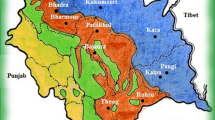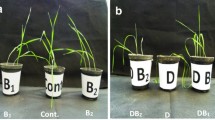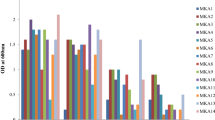Abstract
Plant growth promoting endophytic bacteria Burkholderia phytofirmans PsJN was used to investigate the potential to ameliorate the effects of drought stress on growth, physiology and yield of wheat (Triticum aestivum L.) under natural field conditions. Inoculated and uninoculated (control) seeds of wheat cultivar Sahar 2006 was sown in the field. The plants were exposed to drought stress at different stages of growth (tillering stage and flowering stage) by skipping the respective irrigation. The results showed that drought stress adversely affected the physiological, biochemical and growth parameters of wheat seedlings. It decreased the CO2 assimilation, stomatal conductance, relative water content, transpiration rate and chlorophyll contents in wheat. Inoculation of wheat with PsJN significantly diluted the adverse effects of drought on relative water contents and CO2 assimilation rate thus improving the photosynthetic rate, water use efficiency and chlorophyll content over the uninoculated control. Grain yield was also decreased when plants were exposed to drought stress at the tillering and flowering stage, but inoculation resulted in better grain yield (up to 21 and 18 % higher, respectively) than the respective uninoculated control. Similarly, inoculation improved the ionic balance, antioxidant levels, and also increased the nitrogen, phosphorus, potassium and protein concentration in the grains of wheat. The results suggested that B. phytofirmans strain PsJN could be effectively used to improve the growth, physiology and quality of wheat under drought conditions.





Similar content being viewed by others
References
Ashraf MY, Khan AH, Azmi AR (1992) Cell membrane stability and its relation with some physiological process in wheat. Acta Agron Hung 41:183–191
Bates LS, Waldren RP, Teare ID (1973) Rapid determination of free proline in water-stress studies. Plant Soil 39:205–207
Bradford MM (1976) A rapid and sensitive for the quantitation of microgram quantitites of protein utilizing the principle of protein-dye binding. Anal Biochem 72:248–254
Cakmak I, Marschner H (1992) Magnesium deficiency and high light intensity enhance activities of superoxide dismutase, ascorbate peroxidase, and glutathione reductase in bean leaves. Plant Physiol 98:1222–1227
Chakraborty U, Chakraborty BN, Chakraborty AP, Dey PL (2013) Water stress amelioration and plant growth promotion in wheat plants by osmotic stress tolerant bacteria. World J Microbiol Biotechnol 29:789–803
Chanway CP, Holl FB (1994) Growth of out planted lodepole pine seedlings one year after inoculation with plant growth promoting rhizobacteria. For Sci 40:238–246
Compant S, Reiter B, Sessitsch A, Nowak J, Clément C, AitBarka E (2005) Endophytic colonization of Vitis vinifera L. by plant growth-promoting bacterium, Burkholderia sp. strain PsJN. Appl Environ Microbiol 71:1685–1693
Compant S, Nowak J, Coenye T, Clément C, Ait Barka E (2008) Diversity and occurrence of Burkholderia spp. in the natural environment. FEMS Microbiol Rev 32:607–626
Costa JM, Loper JE (1994) Characterization of siderophore production by the biological control agent Enterobacter cloacae. Mol Plant Microbe Interact 7:440–448
Dodd IC, Belimov AA, Sobeih WY, Safronova VI, Grierson D, Davies WJ (2004) Will modifying plant ethylene status improve plant productivity in water limited environments? In New directions for a diverse planet, proceedings of the 4th international crop science congress, Brisbane, Australia. 26 Sept.–1 Oct. 2004. Available at www.cropscience.org.au/icsc2004/poster/1/3/4/510_doddicref.htm (verified 10 Jan. 2010). Regional Inst., Gosford, NSW, Australia
Fernandez O, Theocharis A, Bordiec S, Feil R, Jasquens L, Clement C, Fontaine F, Ait Barka E (2012) Burkholderia phytofirmans PsJN acclimates grapevine to cold by modulating carbohydrate metabolism. Mol Plant Microbe Interact 25:496–504
Fisher DB (2000) Long distance transport. In: Buchanan BB, Gruissem W, Jones R (eds) Biochemistry and molecular biology of plants. American Society of Plant Biology, Rockville, pp 730–784
Frommel MI, Nowak J, Lazarovits G (1991) Growth enhancement and development modifications of in vitro grown potato (Solanum tuberosum ssp. tuberosum) as affected by a nonfluorescent Pseudomonas sp. Plant Physiol 96:928–936
Glick BR, Penrose DM, Jiping L (1998) A model for the lowering of plant ethylene concentrations by plant growth—promoting bacteria. J Theor Biol 190:63–68
Gupta NK, Gupta S, Kumar S (2001) Effect of water stress on physiological attributes and their relationship with growth and yield of wheat cultivars at different stages. J Agron Crop Sci 186:55–62
Jackson ML (1962) Soil chemical analysis. Prentice Hall, Inc. Englewood Cliffs, NY
Jambunathan N (2010) Determination and detection of reactive oxygen species (ROS), lipid peroxidation, and electrolyte leakage in plants. In: Sunkar R (ed) Plant stress tolerance, methods in molecular biology 639. Humana press, New York, pp 291–297
Kai M, Haustein M, Molina F, Petri A, Scholz B, Piechulla B (2009) Bacterial volatiles and their action potential. Appl Microbiol Biotechnol 81:1001–1012
Kasim WA, Osman ME, Omar MN, Abd El-Daim IA, Bejai S, Meijer J (2013) Control of drought stress in wheat using plant-growth-promoting bacteria. J Plant Growth Regul 32:122–130
Kettlewell PS, Heath WL, Haigh IM (2010) Yield enhancement of droughted wheat by film antitranspirant application: rationale and evidence. Agric Sci 1:143–147
Marulanda A, Barea J-M, Azcon R (2009) Stimulation of plant growth and drought tolerance by native microorganisms (AM fungi and bacteria) from dry environments: mechanisms related to bacterial effectiveness. J Plant Growth Regul 28:115–124
Mayak S, Tirosh T, Glick BR (2004) Plant growth-promoting bacteria that confer resistance to water stress in tomato and pepper. Plant Sci 166:525–530
Mittler R (2002) Oxidative stress, antioxidants and stress tolerance. Trends Plant Sci 7:405–410
Mogensen VO, Jensen HE, Abdur Rab M (1985) Grain yield, yield components, drought sensitivity and water use efficiency of spring wheat subjected to water stress at various growth stages. Irrigation Sci 6:131–140
Nadeem SM, Zahir ZA, Naveed M, Arshad M, Shahzad SM (2006) Variation in growth and ion uptake of maize due to inoculation with plant growth promoting rhizobacteria under salt stress. Soil Environ 25:78–84
Nakano Y, Asada K (1981) Hydrogen peroxide is scavenged by ascorbate-specific peroxidase in spinach chloroplasts. Plant Cell Physiol 22:867–880
Overpeck JT, Cole JE (2006) Abrupt change in Earth’s climate system. Annu Rev Environ Resour 31:1–31
Patten CL, Glick BR (2002) The role of bacterial indoleacetic acid in the development of the host plant root system. Appl Environ Microbiol 68:3795–3801
Pereyra MA, Zalazar CA, Barassi CA (2006) Root phospholipids in Azospirillum inoculated wheat seedlings exposed to water stress. Plant Physiol Biochem 44:873–879
Rodriguez H, Fraga R (1999) Phosphate solubilizing bacteria and their role in plant growth promotion. Biotechnol Adv 17:319–339
Ryan J, Estefan G, Rashid A (2001) Soil and plant analysis laboratory manual, 2nd edn. International Center for Agriculture in Dry Areas (ICARDA), Syria
Sadasivam S, Manickam A (1992) Biochemical methods for agricultural sciences. Willey Eastern Limited, New Delhi
Sandhya V, Ali SZ, Grover M, Reddy G, Venkateswarlu B (2010) Effect of plant growth promoting Pseudomonas spp. on compatible solutes, antioxidant status and plant growth of maize under drought stress. Plant Growth Regul 62:21–30
Saravanakumar D, Kavino M, Raguchander T, Subbian P, Samiyappan R (2011) Plant growth promoting bacteria enhance water stress resistance in green gram plants. Acta Physiol Plant 33:203–209
Sessitsch A, Coenye T, Sturz AV, Vandamme P, Ait Barka E, Faure D, Reiter B, Glick BR, Wang-Pruski G, Nowak J (2005) Burkholderia phytofirmans sp. nov., a novel plant-associated bacterium with plant beneficial properties. Int J Syst Evol Microbiol 55:1187–1192
Singleton VL, Orthofer R, Lamuela-Raventos RM (1999) Analysis of total phenols and other oxidation substrates and antioxidants by means of Folin-Ciocalteu reagent. Methods Enzymol 299:152–178
Smith IK, Vierheller TL, Thorne CA (1988) Assay of glutathione reductase in crude tissue homogenates using 5,5′-dithiobis (2-nitrobenzoic acid). Anal Biochem 175:408–413
Teulat B, Zoumarou-Wallis N, Rotter B, Ben Salem M, Bahri H, This D (2003) QTL for relative water content in field-grown barley and their stability across Mediterranean environments. Theor Appl Genet 108:181–188
Theocharis A, Bordiec S, Fernandez O, Paquis S, Dhondt-Cordelier S, Baillieul F, Clément C, Ait Barka E (2012) Burkholderia phytofirmans PsJN primes Vitis vinifera L. and confers a better tolerance to low nonfreezing temperatures. Mol Plant Microbe Interact 25:241–249
Vardharajula S, Ali SZ, Grover M, Reddy G, Bandi V (2011) Drought-tolerant plant growth promoting Bacillus spp.: effect on growth, osmolytes, and antioxidant status of maize under drought stress. J Plant Interact 6:1–14
Venkateswarulu B, Shanker AK (2009) Climate change and agriculture: adaptation and mitigation strategies. Indian J Agron 54:226–230
Vinocur B, Altman A (2005) Recent advances in engineering plant tolerance to abiotic stress: achievements and limitations. Curr Opin Biotechnol 16:123–132
Vivas A, Marulanda A, Ruiz-Lozano JM, Barea JM, Azcon R (2003) Influence of a Bacillus sp. on physiological activities of two arbuscular mycorrhizal fungi and on plant response to PEG-induced drought stress. Mycorriza 13:249–256
Wahid A, Gelani S, Ashraf M, Foolad MR (2007) Heat tolerance in plants: an overview. Environ Exp Bot 61:199–223
Wang W, Vinocur B, Altman A (2003) Plant responses to drought, salinity and extreme temperatures: towards genetic engineering for stress tolerance. Planta 218:1–14
Warren GF (1998) Spectacular increases in crop yields in the twentieth century. Weed Technol 12:752–760
Watanabe I, Barraquio WL, Guzman MR (1979) Nitrogen-fixing (acetylene reduction) activity and population of aerobic heterotrophic nitrogen-fixing bacteria associated with wetland rice. Appl Environ Microbiol 37:813–815
Wolf B (1982) The comprehensive system of leaf analysis and its use for diagnosing crop nutrient status. Commun Soil Sci Plant Anal 13:1035–1059
Yandigeri MS, Meena KK, Singh D, Malviya N, Singh DP, Solanki MK, Yadav AK, Arora DK (2012) Drought-tolerant endophytic actinobacteria promote growth of wheat (Triticum aestivum) under water stress conditions. Plant Growth Regul 68:411–420
Zahir ZA, Munir A, Asghar HN, Arshad M, Shaharoona B (2008) Effectiveness of rhizobacteria containing ACC-deaminase for growth promotion of peas (Pisum sativum) under drought conditions. J Microbiol Biotechnol 18:958–963
Zahir ZA, Zafar-ul-Hye M, Sajjad S, Naveed M (2011) Comparative effectiveness of Pseudomonas and Serratia sp. containing ACC-deaminase for coinoculation with Rhizobium leguminosarum to improve growth, nodulation, and yield of lentil. Biol Fertil Soils 47:457–465
Acknowledgments
The authors gratefully acknowledge the Higher Education Commission (HEC) of Pakistan for financial support for this research. We are thankful to Dr. Maria L. W. Sels for editing this manuscript.
Author information
Authors and Affiliations
Corresponding author
Rights and permissions
About this article
Cite this article
Naveed, M., Hussain, M.B., Zahir, Z.A. et al. Drought stress amelioration in wheat through inoculation with Burkholderia phytofirmans strain PsJN. Plant Growth Regul 73, 121–131 (2014). https://doi.org/10.1007/s10725-013-9874-8
Received:
Accepted:
Published:
Issue Date:
DOI: https://doi.org/10.1007/s10725-013-9874-8




